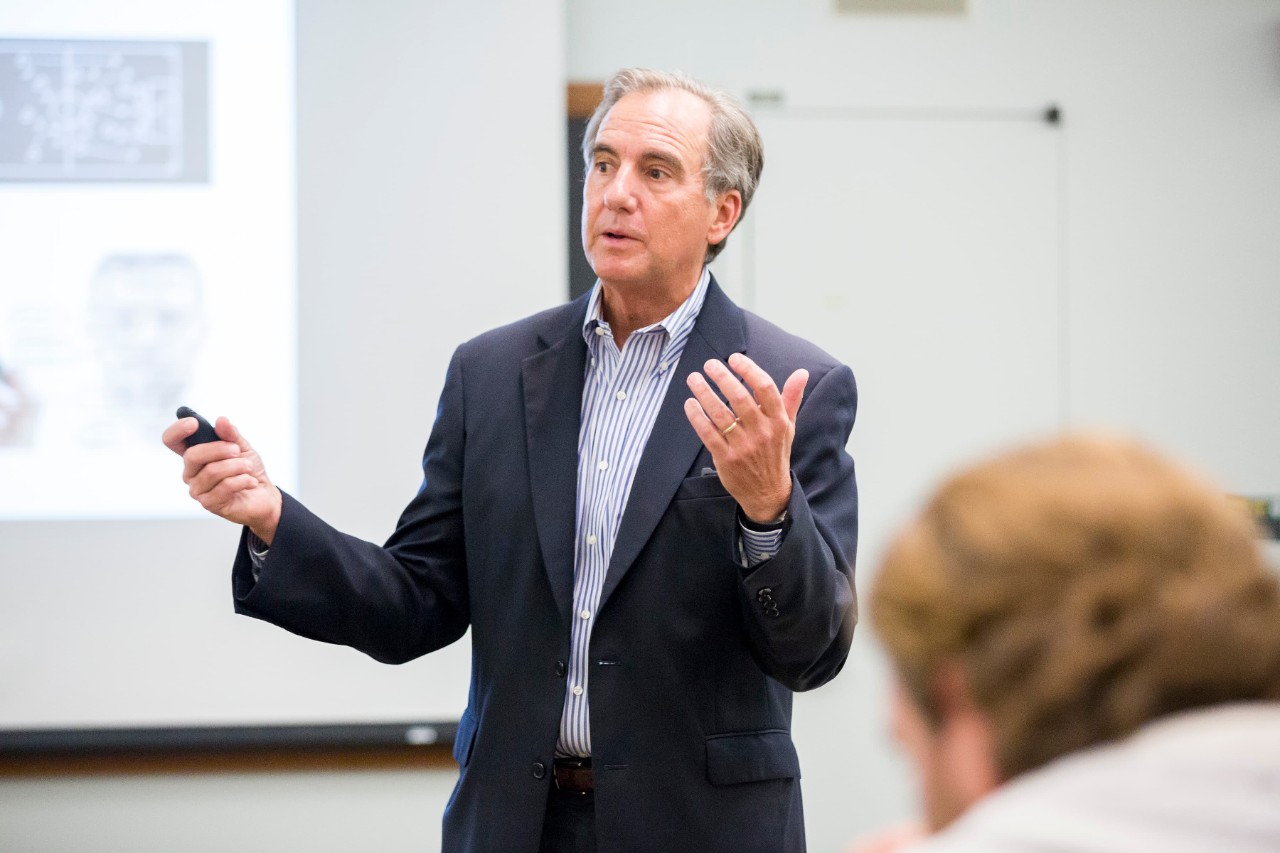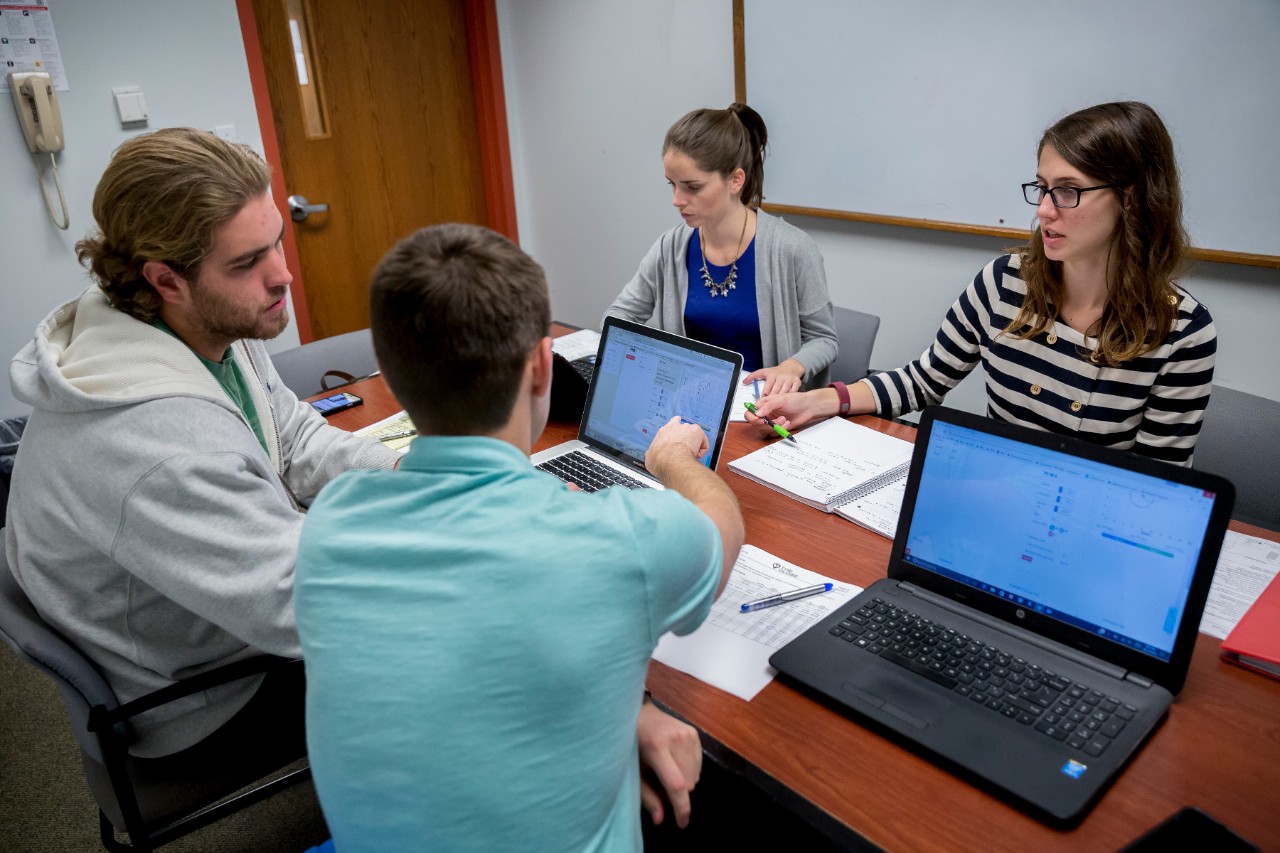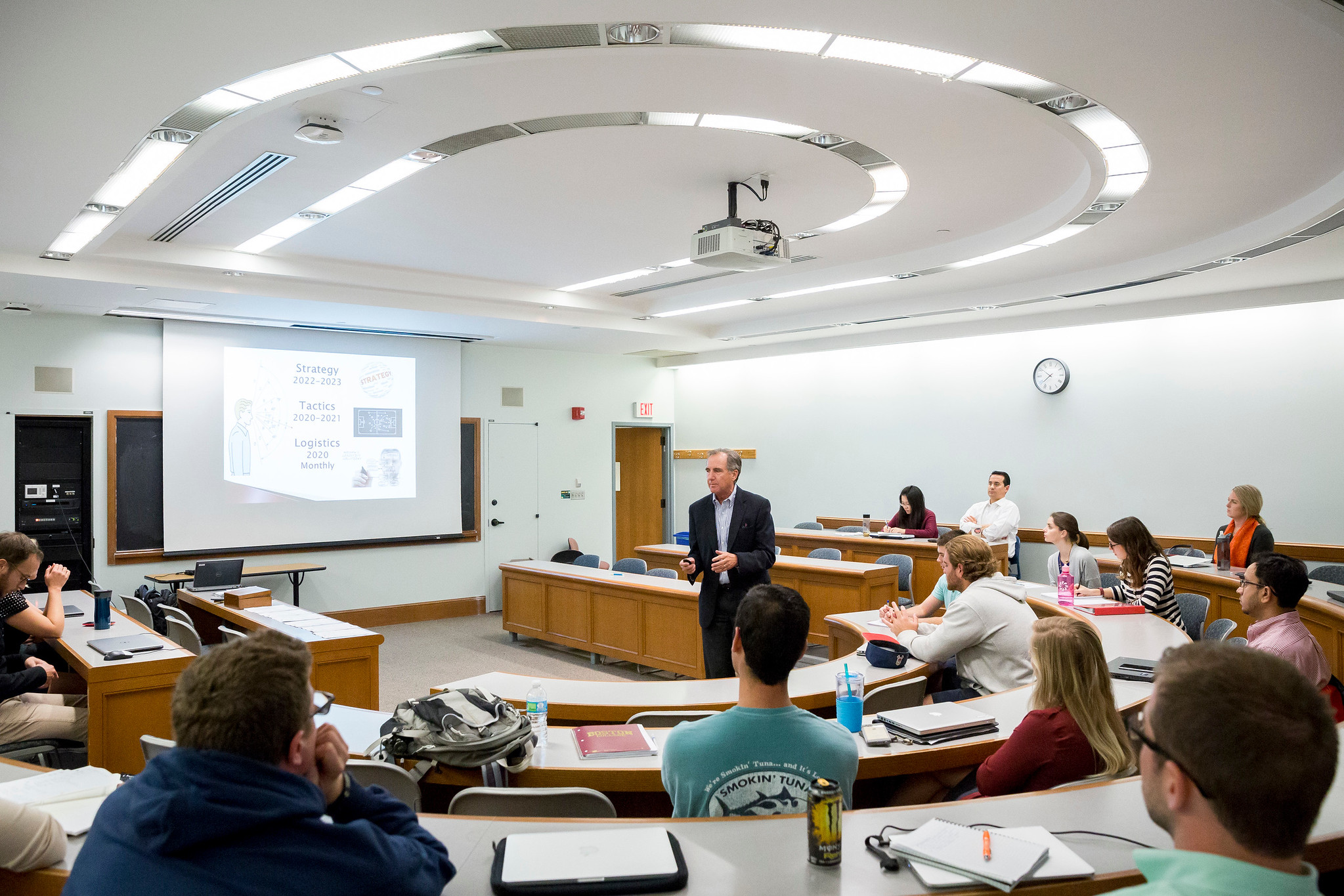
Scott McDermott teaching DNA of Business
“Here we are, on January 2, 2018,” Scott McDermott tells his part-time M.B.A. students on October 3, 2016. The Carroll School professor is not confused about the calendar. He is leading a class, The DNA of Business, which simulates the competition of six fictional companies over an imaginary eight years. And he's unveiling the results of the first “year” of competition among student teams acting as top executives of those companies.
“No team has messed up,” McDermott says during the Monday night lecture in Devlin Hall, citing measures of performance such as sales, profits, and market share. “No one has burst out into an enormous lead. Nobody has cratered, which is good.” Afterward, each team goes into executive session in Fulton Hall to plot its next moves.
Long a staple of military education, simulations have been growing in popularity among business schools and corporate training programs. The idea is to give students a more holistic understanding of how businesses operate and compete, and to do so in an experiential and hands-on way not possible in a pure lecture format. “Cross-functional” and “multi-disciplinary” are how McDermott describes the approach. His class uses an interactive software program called Global DNA, developed by Illinois-based Capsim Management Simulations, a creator of simulation games for schools and employers.
“The environment is as real as can be without using someone else’s money,” said Christopher Wild, M.B.A. ’18, who took the class during its first iteration last summer. A global sourcing specialist with a Massachusetts-based supplier of electrical connectors, Wild added: “A big part of it is team dynamics. You’re not trying to write a paper or put a PowerPoint presentation together. You’re trying to manage a business. It’s a different kind of academic learning.”
In the simulation, firms compete in the medical technology industry, specializing in genetic testing devices. They start out on a level playing field with identical balance sheets and a single product sold only in the United States. Immediately, the teams begin making decisions in four basic areas—research and development, operations and production, sales and marketing, and financing—as they explore global markets.
“ A big part of it is team dynamics. You’re not trying to write a paper or put a PowerPoint presentation together. You’re trying to manage a business. It’s a different kind of academic learning. ”
It’s a zero-sum game: every sale a company makes is one its competitors lose. One decision affects another—for instance, waiting longer to pay suppliers brings higher costs for materials. And the business environment keeps changing.
“The markets are maturing, growing,” said McDermott, a lecturer of management practice and program director at the Carroll School. “So the question is, are people getting there at the right time with the right product at the right cost with the right marketing, with sufficient production capacity in order to get their products sold on the market when the markets demand those products?” He added, “They have to be very agile, like real business.”
During the October 3 class in Devlin Hall, McDermott underscored the point by relating what the hockey legend Wayne Gretzky once said when asked, “How do you know where the puck is?” Gretzky’s reply: “I don’t go where the puck is. I go where the puck is going.” Scenario planning and forecasting are keys to success in both simulation and the real business world, he explained.
As he prepared to send nearly two dozen students into their executive sessions, McDermott also turned their attention to an inescapable part of teamwork. “Conflict is not by its nature bad,” he told them. “It’s how you exit the conflict.” His point: teams need to create a process that allows everyone to participate in the decision-making and then “use the creative friction” to get to an exit. The resolution could be as straightforward as an up-or-down vote.

"Team Digby" in conference, as part of a breakout session from Professor Scott McDermott's DNA of Business class
“We’ve Maxed Out on Debt”
Right after McDermott’s lecture, the six teams settled into small, windowless meeting rooms on the ground floor of Fulton Hall, where they discussed strategies for another hour and 15 minutes. (They also meet at least once a week outside of the one-night-a-week class, often by conference call.) Most of the groups are composed of two men and two women, and their simulated companies have names: Andrews, Baldwin, Chester, Digby, Erie, and Ferris.
The executive team members of Ferris were debating what their “success measures” should be. Part of the game involves assigning percentage values to measures such as stock price, cumulative profits, and market cap; the teams are graded according to their performance on these and other chosen measures. “I just get scared of stock price,” one young man said, arguing against giving primary weight to that particular definition of success. “The market cap is the true worth of the company. We could have a financially healthy company and still have a low stock price.”
Nearby, Baldwin was sticking with a plan to compete for the most part on performance (quality) rather than price. That’s a key component of decision-making in the simulation. “We’re a kind of Tiffany’s company with lower market share and higher profits,” said a male member of that executive team. The team members agreed but also were mindful of pricing trends in the market. “Our competition is racing to the bottom on price,” said a young woman, adding that for now, “we’re not ready to do that.”
Around the corner, a team member of Erie pointed out, “We’ve maxed out on debt. That’s going to affect our stock price.” Another team member broached the subject of foreign markets—“Are we saying no to Asia for now?”
In tackling these and other issues, teams have to draw on practically everything they’ve learned in the M.B.A. program.
“It’s been a really great way of wrapping everything together,” said Jill Cochran, M.B.A. ’18, a member of the Digby team this fall. She was referring to her past courses in areas such as marketing, operations, finance, and accounting. “This course really forces you to understand how they all relate. You have to take all the pieces of a business and make sure they’re aligned with your strategy. And you have to think long term.” Cochran is an assistant vice president at State Street Corporation, where she works on improving the transparency of performance metrics.
This semester, the eight simulated years began in late September and will run until just before Thanksgiving. At that time, the teams will go before a panel of outside judges—styled as a board of directors—and summarize their performance as well as plans for the coming years. Before the two-month period, there are practice rounds and, afterward, so-called “blitz rounds” in which team memberships are scrambled and years of competition are simulated in one week.
“ This course really forces you to understand how they all relate. You have to take all the pieces of a business and make sure they’re aligned with your strategy. And you have to think long term. ”
Bringing the Lessons to Work
Wild said one of his takeaways from the summer class was that the winners are not necessarily the firms with the most revenue. “You could succeed at business by being better at other things,” he said, citing measures such as market cap and profit margins.
He said the simulation also gave him new insight into decisions by C-Suite executives at his firm, Smiths Connectors. “I never quite understood what they did and why they were doing it,” he said, referring to strategic decisions related to financing, research and development, payment terms for suppliers, and other matters. “For me it was a carry-over insight—carried over from the simulated world into the real world.”
McDermott will be taking the simulation concept to the full-time M.B.A. program with a DNA of Business class in the spring. The class is subtitled A Simulated Experience.
...
Well into his lecture on Monday night, October 24, he pointed out, “Today is January 2, 2021. Here’s the moment you’ve been waiting for.” He handed out a 16-page summary report of company and industry performance during the previous year. “Obviously, Digby is very strong,” he said as the students flipped through the pages, “but…”
McDermott did not need to elaborate. There were many more business decisions to make and four more rounds to go.
William Bole is senior writer and editor at the Carroll School.
Photography by Caitlin Cunningham.



